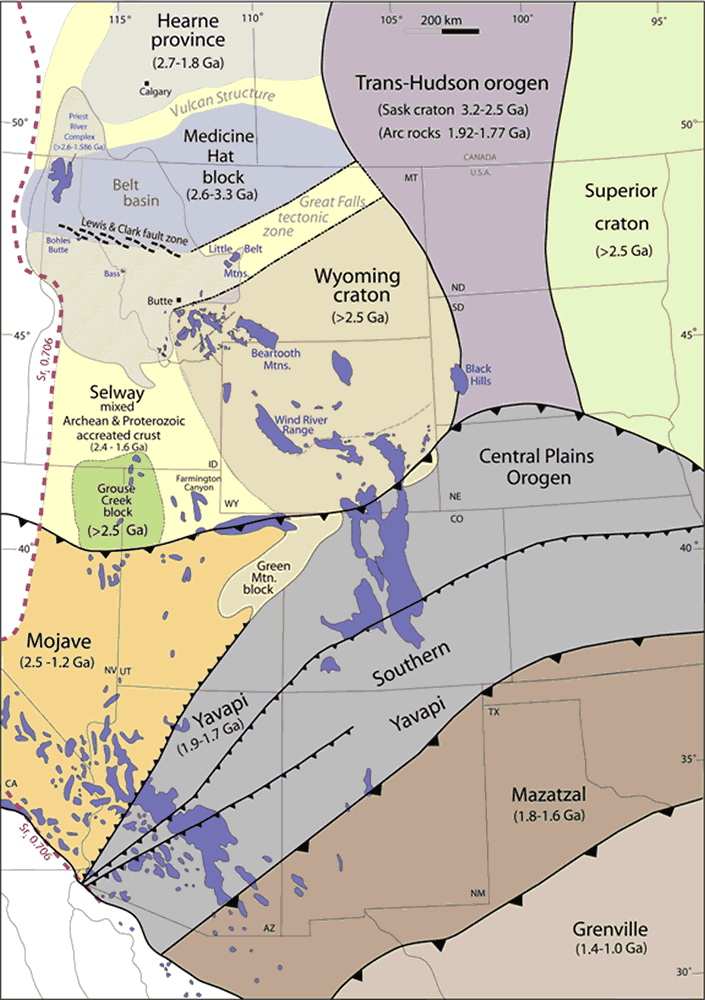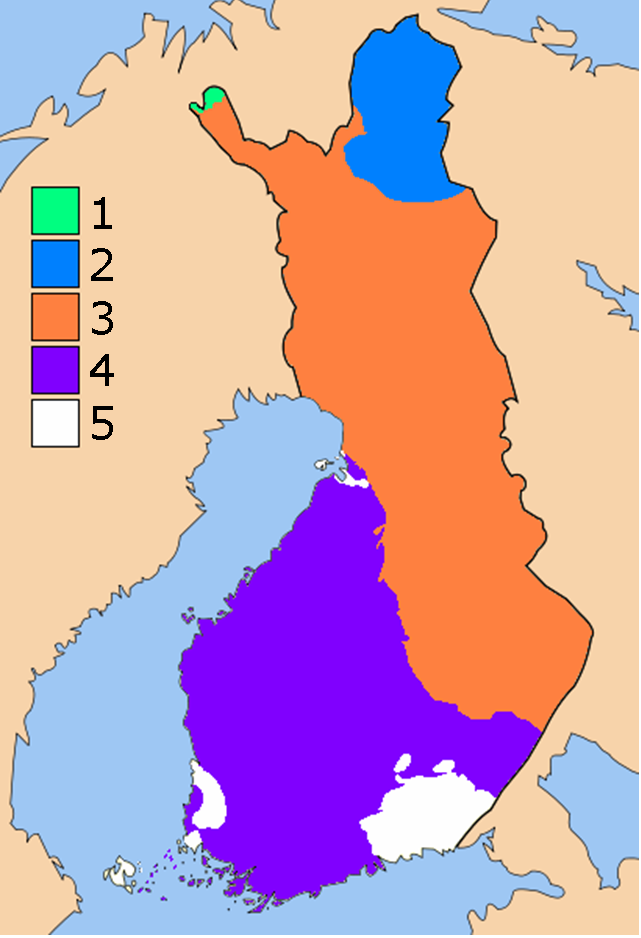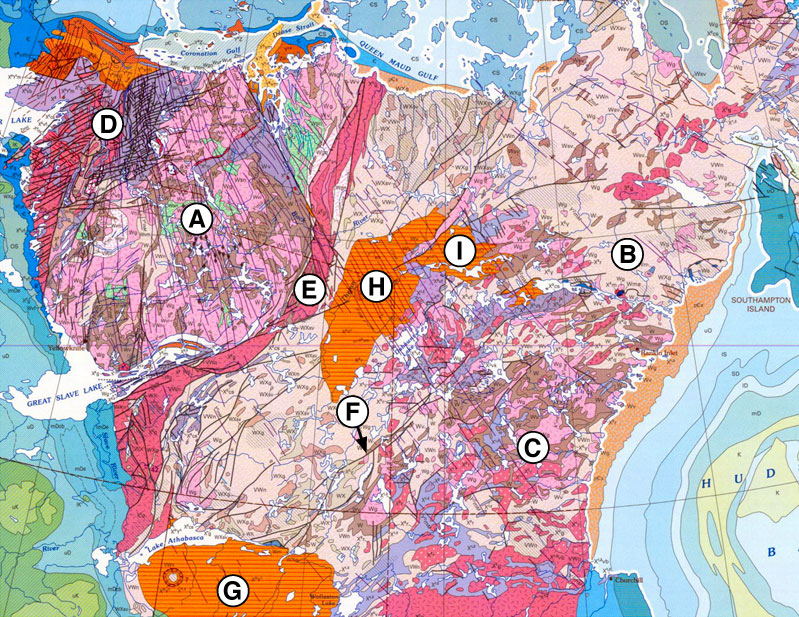|
Paleoproterozoic
The Paleoproterozoic Era (;, also spelled Palaeoproterozoic), spanning the time period from (2.5–1.6 Ga), is the first of the three sub-divisions ( eras) of the Proterozoic Eon. The Paleoproterozoic is also the longest era of the Earth's geological history. It was during this era that the continents first stabilized. Paleontological evidence suggests that the Earth's rotational rate ~1.8 billion years ago equated to 20-hour days, implying a total of ~450 days per year. Atmosphere Before the enormous increase in atmospheric oxygen, almost all existing lifeforms were anaerobic organisms whose metabolism was based on a form of cellular respiration that did not require oxygen. Free oxygen in large amounts is toxic to most anaerobic organisms. Consequently, most died when the atmospheric free oxygen levels soared in an extinction event called the Great Oxidation Event, which brought atmospheric oxygen levels to up to 10% of their current level. The only creatures that sur ... [...More Info...] [...Related Items...] OR: [Wikipedia] [Google] [Baidu] |
Era (geology)
The geologic time scale, or geological time scale, (GTS) is a representation of time based on the rock record of Earth. It is a system of chronological dating that uses chronostratigraphy (the process of relating strata to time) and geochronology (scientific branch of geology that aims to determine the age of rocks). It is used primarily by Earth scientists (including geologists, paleontologists, geophysicists, geochemists, and paleoclimatologists) to describe the timing and relationships of events in geologic history. The time scale has been developed through the study of rock layers and the observation of their relationships and identifying features such as lithologies, paleomagnetic properties, and fossils. The definition of standardized international units of geologic time is the responsibility of the International Commission on Stratigraphy (ICS), a constituent body of the International Union of Geological Sciences (IUGS), whose primary objective is to precisely defi ... [...More Info...] [...Related Items...] OR: [Wikipedia] [Google] [Baidu] |
Great Oxidation Event
The Great Oxidation Event (GOE), also called the Great Oxygenation Event, the Oxygen Catastrophe, the Oxygen Revolution, the Oxygen Crisis, or the Oxygen Holocaust, was a time interval during the Paleoproterozoic era when the Earth's atmosphere and the shallow ocean first experienced a rise in the amount of oxygen. This began approximately 2.460–2.426 Ga (billion years) ago, during the Siderian period, and ended approximately 2.060 Ga, during the Rhyacian. Geological, isotopic, and chemical evidence suggests that biologically-produced molecular oxygen ( dioxygen, O2) started to accumulate in Earth's atmosphere and changed it from a weakly reducing atmosphere practically free of oxygen into an oxidizing atmosphere containing abundant oxygen, with oxygen levels being as high as 10% of their present atmospheric level by the end of the GOE. The sudden injection of toxic oxygen into an anaerobic biosphere may have caused the extinction of many existing anaerobic species ... [...More Info...] [...Related Items...] OR: [Wikipedia] [Google] [Baidu] |
Great Oxygenation Event
The Great Oxidation Event (GOE), also called the Great Oxygenation Event, the Oxygen Catastrophe, the Oxygen Revolution, the Oxygen Crisis, or the Oxygen Holocaust, was a time interval during the Paleoproterozoic era when the Earth's atmosphere and the shallow ocean first experienced a rise in the amount of oxygen. This began approximately 2.460–2.426 Ga (billion years) ago, during the Siderian period, and ended approximately 2.060 Ga, during the Rhyacian. Geological, isotopic, and chemical evidence suggests that biologically-produced molecular oxygen ( dioxygen, O2) started to accumulate in Earth's atmosphere and changed it from a weakly reducing atmosphere practically free of oxygen into an oxidizing atmosphere containing abundant oxygen, with oxygen levels being as high as 10% of their present atmospheric level by the end of the GOE. The sudden injection of toxic oxygen into an anaerobic biosphere may have caused the extinction of many existing anaerobic spec ... [...More Info...] [...Related Items...] OR: [Wikipedia] [Google] [Baidu] |
Trans-Hudson Orogeny
The Trans-Hudson orogeny or Trans-Hudsonian orogeny was the major mountain building event (orogeny) that formed the Precambrian Canadian Shield and the North American Craton (also called Laurentia), forging the initial North American continent. It gave rise to the Trans-Hudson orogen (THO), or Trans-Hudson Orogen Transect (THOT), (also referred to as the Trans-Hudsonian Suture Zone (THSZ) or Trans-Hudson suture) which is the largest Paleoproterozoic orogenic belt in the world. It consists of a network of belts that were formed by Proterozoic crustal accretion and the collision of pre-existing Archean continents. The event occurred 2.0–1.8 billion years ago. The Trans-Hudson orogen sutured together the Hearne- Rae, Superior, and Wyoming cratons to form the cratonic core of North America in a network of Paleoproterozoic orogenic belts. These orogenic belts include the margins of at least nine independent microcontinents that were themselves sections of at least three forme ... [...More Info...] [...Related Items...] OR: [Wikipedia] [Google] [Baidu] |
Yavapai Orogeny
The Yavapai orogeny was an orogenic (mountain-building) event in what is now the Southwestern United States that occurred between 1710 and 1680 million years ago ( Mya), in the Statherian Period of the Paleoproterozoic. Recorded in the rocks of New Mexico and Arizona, it is interpreted as the collision of the 1800-1700 Mya age Yavapai island arc terrane with the proto-North American continent. This was the first in a series of orogenies within a long-lived convergent boundary along southern Laurentia that ended with the ca. 1200–1000 Mya Grenville orogeny during the final assembly of the supercontinent Rodinia, which ended an 800-million-year episode of convergent boundary tectonism. Description Age and isotope data show that southern North America is composed of a series of northeast-trending provinces representing island arc terranes accreted onto the 1800 Mya core of Laurentia. These are the Yavapai province (1800–1700 Mya), the Mazatzal province (1700–1650 Mya), the Gr ... [...More Info...] [...Related Items...] OR: [Wikipedia] [Google] [Baidu] |
Svecofennian Orogeny
The Svecofennian orogeny is a series of related orogenies that resulted in the formation of much of the continental crust in what is today Sweden and Finland plus some minor parts of Russia. The orogenies lasted from about 2000 to 1800 million years ago during the Paleoproterozoic Era. The resulting orogen is known as the Svecofennian orogen or Svecofennides. To the west and southwest the Svecofennian orogen limits with the generally younger Transscandinavian Igneous Belt. It is assumed that the westernmost fringes of the Svecofennian orogen have been reworked by the Sveconorwegian orogeny just as the western parts of the Transscandinavian Igneous Belt has. The Svecofennian orogeny involved the accretion of numerous island arcs in such manner that the pre-existing craton grew with this new material from what is today northeast to the southwest. The accretion of the island arcs was also related to two other processes that occurred in the same period; the formation of magma tha ... [...More Info...] [...Related Items...] OR: [Wikipedia] [Google] [Baidu] |
Nagssugtoqidian Orogeny
The Nagssugtoqidian orogeny was a late Paleoproterozoic mountain-building event that affected Greenland during the period 1.91 to 1.77 Ga. The orogenic belt formed during this event marks the northern boundary of the mainly Archaean North Atlantic Craton. It was first recognised by Ramberg in 1949, based on its effect on the Kangaamiut dike swarm. The subsequent recognition of magmatic terranes representing past island arcs and two potential sutures representing now vanished subduction zones within the belt, have enabled its interpretation in terms of plate tectonics Plate tectonics (from the la, label=Late Latin, tectonicus, from the grc, τεκτονικός, lit=pertaining to building) is the generally accepted scientific theory that considers the Earth's lithosphere to comprise a number of large .... References {{Reflist Orogenies of North America Proterozoic North America Geology of Greenland Paleoproterozoic orogenies ... [...More Info...] [...Related Items...] OR: [Wikipedia] [Google] [Baidu] |
Proterozoic
The Proterozoic () is a geological eon spanning the time interval from 2500 to 538.8million years ago. It is the most recent part of the Precambrian "supereon". It is also the longest eon of the Earth's geologic time scale, and it is subdivided into three geologic eras (from oldest to youngest): the Paleoproterozoic, Mesoproterozoic, and Neoproterozoic. The Proterozoic covers the time from the appearance of oxygen in Earth's atmosphere to just before the proliferation of complex life (such as trilobites or corals) on the Earth. The name ''Proterozoic'' combines two forms of ultimately Greek origin: meaning 'former, earlier', and , 'of life'. The well-identified events of this eon were the transition to an oxygenated atmosphere during the Paleoproterozoic; the evolution of eukaryotes; several glaciations, which produced the hypothesized Snowball Earth during the Cryogenian Period in the late Neoproterozoic Era; and the Ediacaran Period (635 to 538.8 Ma) which is chara ... [...More Info...] [...Related Items...] OR: [Wikipedia] [Google] [Baidu] |
Penokean Orogeny
The Penokean orogeny was a mountain-building episode that occurred in the early Proterozoic about 1.86 to 1.83 billion years ago, in the area of Lake Superior, North America. The core of this orogeny, the Churchill Craton, is composed of terranes derived from the 1.86–1.81 Ga collision between the Superior and North Atlantic cratons. The orogeny resulted in the formation of the Nena and Arctica continents, which later merged with other continents to form the Columbia supercontinent. The name was first proposed by in reference to what is known as the Penokee Range, sometimes incorrectly called the Gogebic Range, in northern Michigan and Wisconsin. The Paleoproterozoic Penokean orogeny developed in an embayment on the southern margin of the Superior Craton. It extends east from Minnesota to the Grenville orogen near Lake Huron and south to the Central Plain in Wisconsin. It is composed of two domains separated by the Niagara Fault Zone: the southern, internal domain, ... [...More Info...] [...Related Items...] OR: [Wikipedia] [Google] [Baidu] |
Akitkan Orogen
The Akitkan Range (russian: хребет Акиткан; zh, 阿基特坎山) is a mountain range in Irkutsk Oblast and Buryatia, Russian Federation.Google Earth The Paleoproterozoic Akitkan Orogen is named after the range. History Between 1855 and 1858 Ivan Kryzhin (d. 1884) took part in the Eastern Siberian expedition led by Russian astronomer and traveler Ludwig Schwarz. In 1857 he mapped the Kirenga River and, while exploring its right tributary, the Cherepanikha, Kryzhin discovered the formerly unknown Akitkan Range rising above the area of its source. The North Baikal Highlands, where the range rises, were explored between 1909 and 1911 by Russian geologist Pavel Preobrazhensky (1874 - 1944). He surveyed the river valley of the Chechuy, a right tributary of the Lena with its sources in the Akitkan. Overcoming numerous difficulties, Preobrazhensky managed to map for the first time a stretch of the Akitkan Range. Geography The Akitkan stretches roughly northwards for ... [...More Info...] [...Related Items...] OR: [Wikipedia] [Google] [Baidu] |
Wopmay Orogen
The Wopmay orogen is a Paleoproterozoic orogenic belt in northern Canada which formed during the collision between the Hottah terrane (north of the Hottah Lake), a continental magmatic arc, and the Archean Slave Craton at about 1.88 Ga (billion years). The collision lead to the short-lived Calderian orogeny. The formation was named for Wilfrid Reid "Wop" May, OBE, DFC (April 20, 1896 – June 21, 1952), a Canadian flying ace in the First World War and a leading post-war aviator. It is approximately 500 km along the north–south axis, and 200 km along the east–west axis at its widest point, tapering at both the northern and southern ends. Geological setting The Wopmay orogen can be subdivided into (east to west): a passive continental margin, the Wopmay fault zone, the Great Bear magmatic zone, and the Hottah terrane. The passive margin developed around 1970–1890 Ma on-top of the Slave Craton. The Wopmay fault zone is probably a suture betw ... [...More Info...] [...Related Items...] OR: [Wikipedia] [Google] [Baidu] |
Eburnean Orogeny
The Eburnean orogeny, or Eburnean cycle, was a series of tectonic, metamorphic and plutonic events in what is now West Africa during the Paleoproterozoic era about 2200–2000 million years ago. During this period the Birimian domain in West Africa was established and structured. Eburnian faults are found in the Eglab shield to the north of the West African craton and in the Man Shield to the south of the craton. There is evidence of three major Eburnean magmatic events in the Eglab shield. Between 2210 and 2180 Ma, a metamorphosed batholith was formed in the Lower Reguibat Complex (LRC). Around 2090 Ma, a syntectonic trondhjemitic pluton intruded into the Archaean reelects of the Chegga series. Around 2070 Ma an asthenospheric upwelling released a large volume of post-orogenic magmas. Eburnian trends within the Eglab shield were repeatedly reactivated from the Neoproterozoic to the Mesozoic. See also *Geology of Ghana The geology of Ghana is primarily very ancient cryst ... [...More Info...] [...Related Items...] OR: [Wikipedia] [Google] [Baidu] |

.jpg)



